|
|
|
Sort Order |
|
|
|
Items / Page
|
|
|
|
|
|
|
| Srl | Item |
| 1 |
ID:
094079
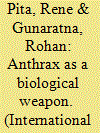

|
|
|
|
|
| Publication |
2010.
|
| Summary/Abstract |
On 5 October 2001, not even a month after the terrorist attacks of 11 September 2001 (9/11), a person died in Boca Raton, Florida, of inhalational anthrax. The low incidence of this disease (only eighteen occupational exposure cases were recorded in the United States during the twentieth century);1 the concern generated after 9/11 regarding possible al-Qaeda attacks using chemical, biological, radiological, or nuclear (CBRN) weapons; and the fact that the etiological agent of this illness is the biological weapon (BW) par excellence, triggered alarms when the cause of this death was made public. Traces of the biological agent were detected a few days later in American Media, Inc. (AMI) facilities, where the deceased worked. Two envelopes, postmarked 18 September, addressed to an NBC reporter and to the editor of the New York Post, both with threatening messages and indicating that they contained anthrax, were retrieved. For a series of reasons, the logical thing to do at that time was to relate these mailings to al-Qaeda. Among those reasons were the proximity in time of the postal mailings with the 9/11 terrorist attacks; the messages included in the envelopes had 9/11 allusions and phrases such as "Death to America," "Death to Israel," and "Allah is great"; and the suspected interest of the 9/11 suicide terrorists in agricultural aircraft to disseminate chemical or biological agents. This is when what is colloquially known as the "Amerithrax"-the name that the Federal Bureau of Investigation (FBI) gave to the criminal investigation-investigation began.
|
|
|
|
|
|
|
|
|
|
|
|
|
|
|
|
| 2 |
ID:
022026
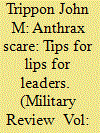

|
|
|
|
|
| Publication |
March-April 2002.
|
| Description |
18-23
|
|
|
|
|
|
|
|
|
|
|
|
|
|
|
|
| 3 |
ID:
020992
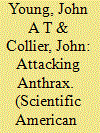

|
|
|
|
|
| Publication |
2002.
|
| Description |
48-59
|
|
|
|
|
|
|
|
|
|
|
|
|
|
|
|
| 4 |
ID:
098833
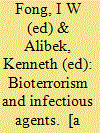

|
|
|
|
|
| Publication |
London, Springer, 2009.
|
| Description |
xvi, 273p.
|
| Standard Number |
9781441912657pbk
|
|
|
|
|
|
|
|
|
|
|
|
Copies: C:1/I:0,R:0,Q:0
Circulation
| Accession# | Call# | Current Location | Status | Policy | Location |
| 055201 | 303.625/FON 055201 | Main | On Shelf | General | |
|
|
|
|
| 5 |
ID:
021190
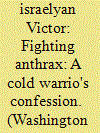

|
|
|
|
|
| Publication |
Spring 2002.
|
| Description |
17-30
|
|
|
|
|
|
|
|
|
|
|
|
|
|
|
|
| 6 |
ID:
149011
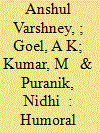

|
|
|
|
|
| Summary/Abstract |
Anthrax, caused by Bacillus anthracis is known to occur globally since antiquity. Besides being an important biothreat agent, it is an important public health importance pathogen also in countries like India. B. anthracis secretes three distinct toxins, namely protective antigen (PA), lethal factor (LF) and edema factor (EF). PA is the central moiety of the anthrax toxin complex and therefore has been a molecule of choice for vaccine development. PA has four different domains with different functions. In this study, the major domains of PA were cloned and expressed in bacterial system. The purified recombinant proteins were used to determine the humoral immune response by ELISA using 43 human cutaneous anthrax serum samples. The maximum immunoreactivity was observed with the whole PA protein followed by domain 2, 4 and 1. The study corroborated that in addition to full PA, individual domain 2 and 4 can also be good target for vaccine development as well as for serodiagnostic assays for cutaneous anthrax
|
|
|
|
|
|
|
|
|
|
|
|
|
|
|
|
| 7 |
ID:
021674
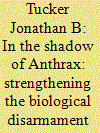

|
|
|
|
|
| Publication |
Spring 2002.
|
| Description |
112-121
|
|
|
|
|
|
|
|
|
|
|
|
|
|
|
|
| 8 |
ID:
021442
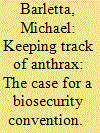

|
|
|
|
|
| Publication |
May-June 2002.
|
| Description |
57-62
|
|
|
|
|
|
|
|
|
|
|
|
|
|
|
|
| 9 |
ID:
182954
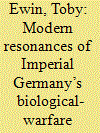

|
|
|
|
|
| Summary/Abstract |
This article summarizes published and archival information about Imperial Germany’s attempts to infect draft animals in some Allied and neutral countries with anthrax and glanders during World War I. It casts doubt on claims that the Isle of Man was among the places affected. It considers the extent to which contemporary terrorist activity more closely resembles German biological sabotage plots than it does most modern state weapons-of-mass-destruction programs.
|
|
|
|
|
|
|
|
|
|
|
|
|
|
|
|
| 10 |
ID:
107466


|
|
|
|
|
| Publication |
2011.
|
| Summary/Abstract |
An attack with Bacillus anthracis ("anthrax") is a known threat to the United States. When weaponized, it can cause inhalation anthrax, the deadliest form of the disease. Due to the rapid course of inhalation anthrax, delays in initiation of antibiotics may decrease survival chances. Because a rapid response would require cooperation from the public, there is a need to understand the public's response to possible mass dispensing programs. To examine the public's response to a mass prophylaxis program, this study used a nationally representative poll of 1,092 adults, supplemented by a targeted focus on 3 metropolitan areas where anthrax attacks occurred in 2001: New York City (n=517), Washington, DC (n=509), and Trenton/Mercer County, NJ (n=507). The poll was built around a "worst-case scenario" in which cases of inhalation anthrax are discovered without an identified source and the entire population of a city or town is asked to receive antibiotic prophylaxis within a 48-hour period. Findings from this poll provide important signs of public willingness to comply with public health recommendations for obtaining antibiotics from a dispensing site, although they also indicate that public health officials may face several challenges to compliance, including misinformation about the contagiousness of inhalation anthrax; fears about personal safety in crowds; distrust of government agencies to provide sufficient, safe, and effective medicine; and hesitation about ingesting antibiotic pills after receiving them. In general, people living in areas where anthrax attacks occurred in 2001 had responses similar to those of the nation as a whole.
|
|
|
|
|
|
|
|
|
|
|
|
|
|
|
|
| 11 |
ID:
126125


|
|
|
|
|
| Publication |
2012.
|
| Summary/Abstract |
The 2001 anthrax attacks emphasized the need to develop outreach that would more effectively support racial/ethnic minority populations during a bioterrorism incident. Given the importance of antibiotic prophylaxis in a future anthrax attack, it should be a priority to better support racial/ethnic minorities in mass dispensing programs. To examine the needs and perspectives of racial/ethnic minorities, this study used a nationally representative poll of 1,852 adults, including 1,240 whites, 261 African Americans, and 282 Hispanics. The poll examined public reactions to a ''worst-case scenario'' in which cases of inhalation anthrax are discovered without an identified source and the entire population of a city or town is asked to receive antibiotic prophylaxis within 48 hours. Findings suggest willingness across all racial/ethnic groups to comply with recommendations to seek prophylaxis at dispensing sites. However, findings also indicate possible barriers for racial/ethnic minorities, including greater concern about pill safety and multiple attacks as well as lesser knowledge about inhalation anthrax. Across all racial/ethnic groups, roughly half would prefer to receive antibiotics at mass dispensing sites rather than through the US Postal Service. People in racial/ethnic minority groups were more likely to say this preference stems from a desire to speak with staff or to exchange medication formulation or type. Findings suggest the need for tailored outreach to racial/ethnic minorities through, for example, emphasis on key messages and enhanced understandability in communications, increased staff for answering questions in relevant dispensing sites, and long-term trust building with racial/ethnic minority communities.
|
|
|
|
|
|
|
|
|
|
|
|
|
|
|
|
| 12 |
ID:
021358
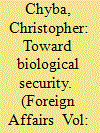

|
|
|
|
|
| Publication |
May-June 2002.
|
| Description |
122-136
|
|
|
|
|
|
|
|
|
|
|
|
|
|
|
|
|
|
|
|
|